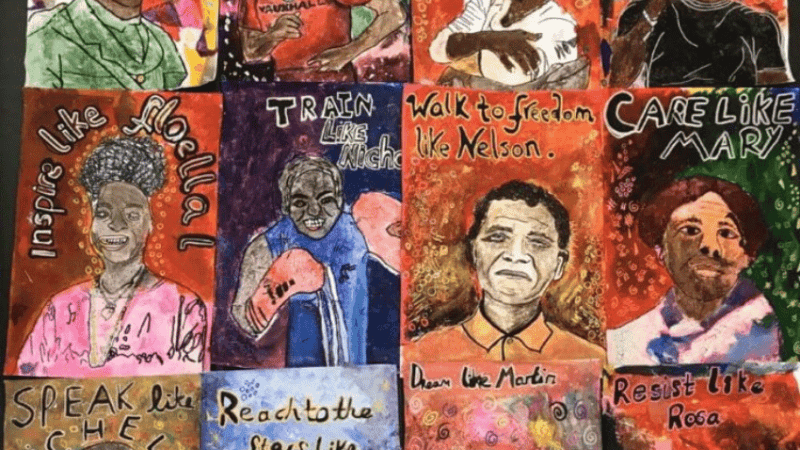Holocaust Memorial Day 2025 – Best teaching resources for primary and secondary

Holocaust Memorial Day takes place on 27th January – use these resources to get involved and educate your students…

- by Teachwire
- Classroom expertise and free resources for teachers
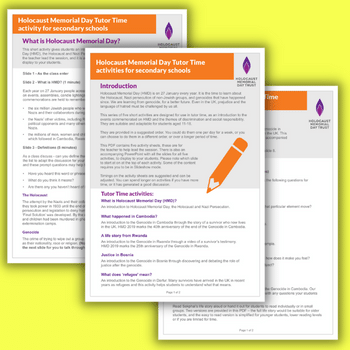
We explore the significance of Holocaust Memorial Day, this year’s theme, and the importance of teaching children about the Holocaust with sensitivity and care…
What is Holocaust Memorial Day?
Holocaust Memorial Day takes place to remember the six million Jews murdered during the Holocaust, alongside the millions of other people killed under Nazi Persecution.
It’s also used to remember genocides that followed in Cambodia, Rwanda, Bosnia and Darfur.
Antisemitism and anti-Muslim hatred has increased significantly in the UK, and globally, following the attacks in Israel by Hamas and the subsequent war in Gaza.
Beki Martin, executive director of charity Facing History and Ourselves, says that Holocaust Memorial Day “provides us with the critical opportunity to educate young people about this terrible history, as well as how they can stand up against acts of bigotry and hatred today.”
When is Holocaust Memorial Day?
Holocaust Memorial Day takes place each year on the 27th January (a Monday in 2025). This is the anniversary of the liberation of Auschwitz-Birkenau, the largest Nazi death camp.
Holocaust Memorial Day 2025 marks the 80th anniversary of the liberation of Auschwitz-Birkenau.
What is the theme for Holocaust Memorial Day 2025?
The theme for Holocaust Memorial Day 2025 is ‘For a Better Future’. It focuses on the idea that there are many things we can all do to create a better future. Read all about 2025’s theme on the Holocaust Memorial Day Trust website.
Holocaust Memorial Day resources
Tutor time activities for secondary schools
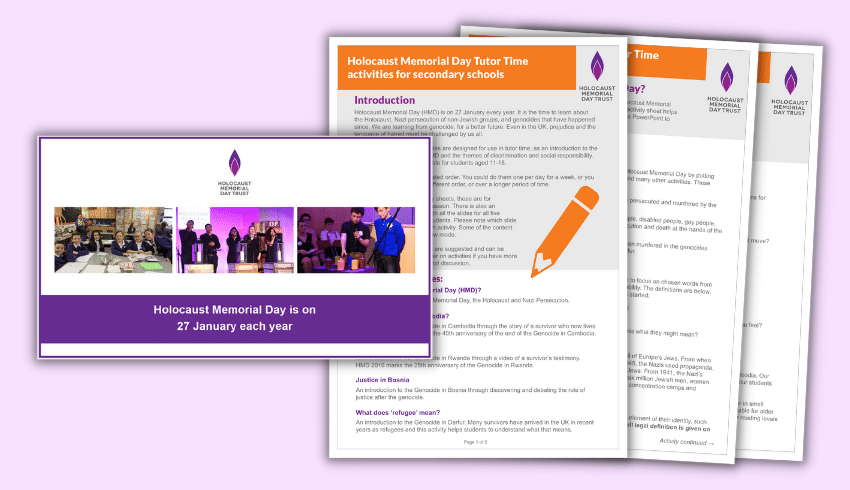
This set of five Holocaust Memorial Day activities is designed for use in tutor times. It includes short activities and discussion questions to introduce students to the genocides remembered on Holocaust Memorial Day.
Students will learn about people affected by the Holocaust and genocide and explore a range of themes. They are challenged to think about their own social responsibility, and what we can do to make a difference today.
Holocaust Memorial Day assemblies for primary and secondary
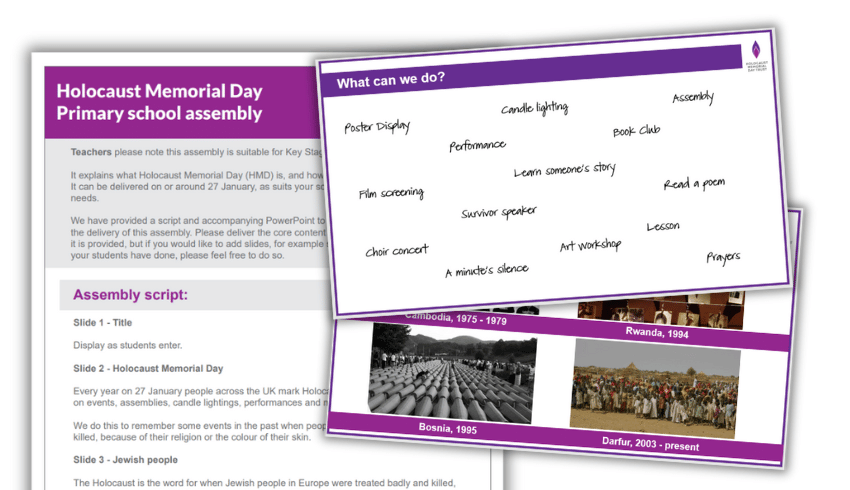
These Holocaust Memorial Day assemblies introduce students to Holocaust Memorial Day, what we are commemorating, and how we can mark it. They include poetry and film to engage students with the day.
There are versions for both primary and secondary. They feature a script and presentation, designed to be used together by teachers to deliver the assembly.

Alternatively, download these PowerPoint Assemblies for KS3 and KS4 Students from Facing History and Ourselves.
Pupils will listen to testimonies from some of the ordinary people who came to the UK as part of the Kindertransport. They’ll also consider the importance of this testimony, and of memorialisation.
National Literacy Trust Holocaust Memorial Day live event

To mark Holocaust Memorial Day, take part in a free live event that will support young people’s literacy skills while helping them learn about the past.
Aimed at KS3 students, pupils will join an online 45-minute conversation with author Tom Palmer, Holocaust survivor Alfred Garwood and child survivor Antoinette Mutabazi.
Read the first chapters of Tom Palmer’s award-winning children’s historical fiction, After the War – from Auschwitz to Ambleside.
Writing about Holocaust survivors
In the above film, author Tom Palmer guides KS3 students through the process of writing a story about a Holocaust survivor.
You can also download resources created by the National Literacy Trust to guide pupils through that writing process and Tom’s We Will Tell Your Stories writing scrapbook that can be used as an inspiration or raw material.
Discrimination lesson plan for secondary

Made in partnership with Stand Up! Education Against Discrimination, this discrimination lesson plan will help your students learn how discrimination was used during the Holocaust, Nazi Persecution and the Genocide in Rwanda.
You will discuss antisemitism and anti-Muslim hatred in society today, and what to do if you are the victim or a witness to a hate crime.
On-demand webinar for teachers
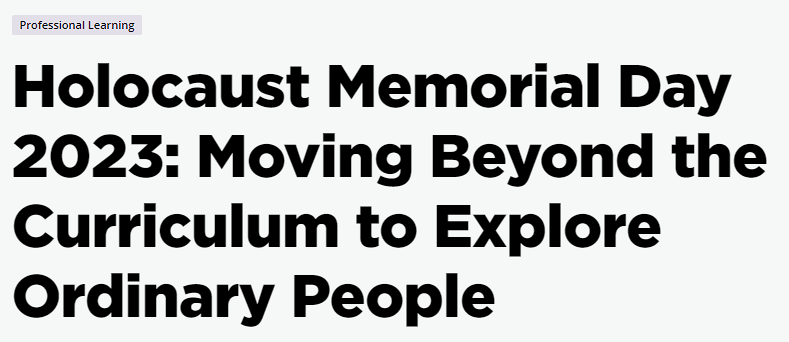
Take a look at Facing History and Ourselves’ one-hour on-demand webinar, which provides practical activities and support if you’re planning to hold assemblies, tutor time or PSHE sessions.
It’s perfect if you’re not necessarily a subject specialist and will leave you feeling fully equipped to have emotive and difficult conversations.
Take primary pupils to the National Holocaust Centre and Museum

The Journey is an award-winning exhibition at the National Holocaust Centre and Museum in Laxton, Nottinghamshire, designed especially for primary schools.
Pupils will follow the story of a young Jewish boy from 1930s Nazi Germany to safety in England via the Kindertransport.
Teaching Holocaust and human behaviour

Facing History and Ourselves has designed this 15-lesson unit for history, RS, English and PSHE teachers. It leads students through a detailed, challenging study of the Holocaust that asks what this history can teach us about the power and impact of choices.
Discussing contemporary antisemitism
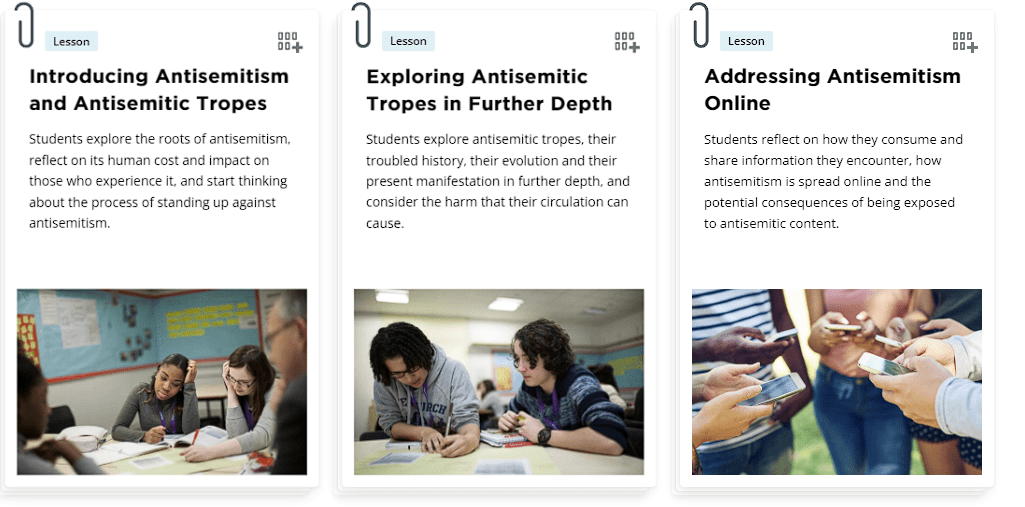
Discussing Contemporary Antisemitism in the Classroom is a four-lesson unit for RS, PSHE, history and English lessons.
It’s created by Facing History and Ourselves. The resource asks students to reflect on antisemitism, how it manifests today and what we can do to challenge it.
What was the Holocaust?

You need a sensitive approach if you’re going to teach the Holocaust to young pupils. If you’re after a good, child-friendly starting point for what the Holocaust was and what happened, try this CBBC page.
It has short descriptions of events and people, along with animated videos and links to other relevant sources.
Holocaust Memorial Day Trust resources
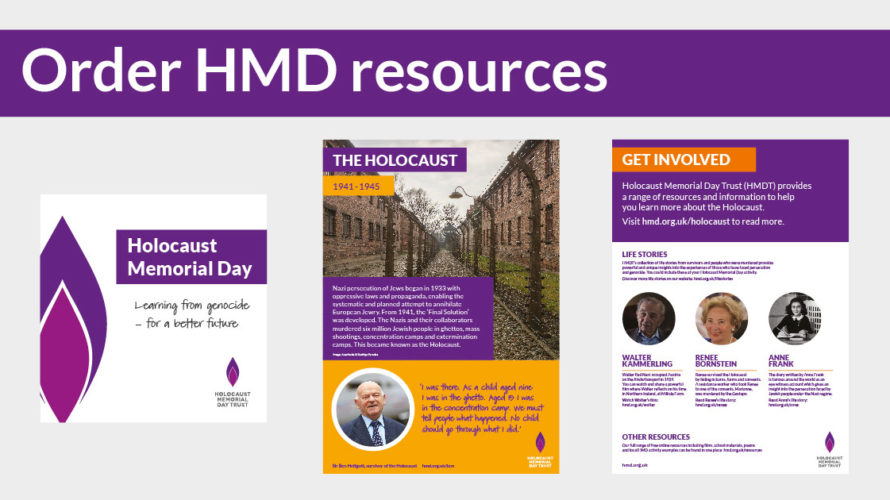
On the Holocaust Memorial Trust website you can order free Holocaust Memorial Day booklets, stickers and pin badges to use in your own Holocaust Memorial Day activity. Or, if you prefer, you can print the booklets and posters off yourself.
This year there is a competition where students have to design a memorial for the 30th anniversary of the genocide in Bosnia.
Holocaust Memorial commemoration video
If you’re looking for something to share with students, this award-winning video from the UCU comes in at around 25 minutes, and features personal testimonials of the Holocaust.
The film is accompanied by a short publication of testimonials by UCU members. It also includes others who survived genocides in Armenia, Bosnia, Cambodia, Darfur and Rwanda.
Find more Holocaust Memorial Day videos and resources from UCU here.
Exploring the Holocaust KS3 scheme of work
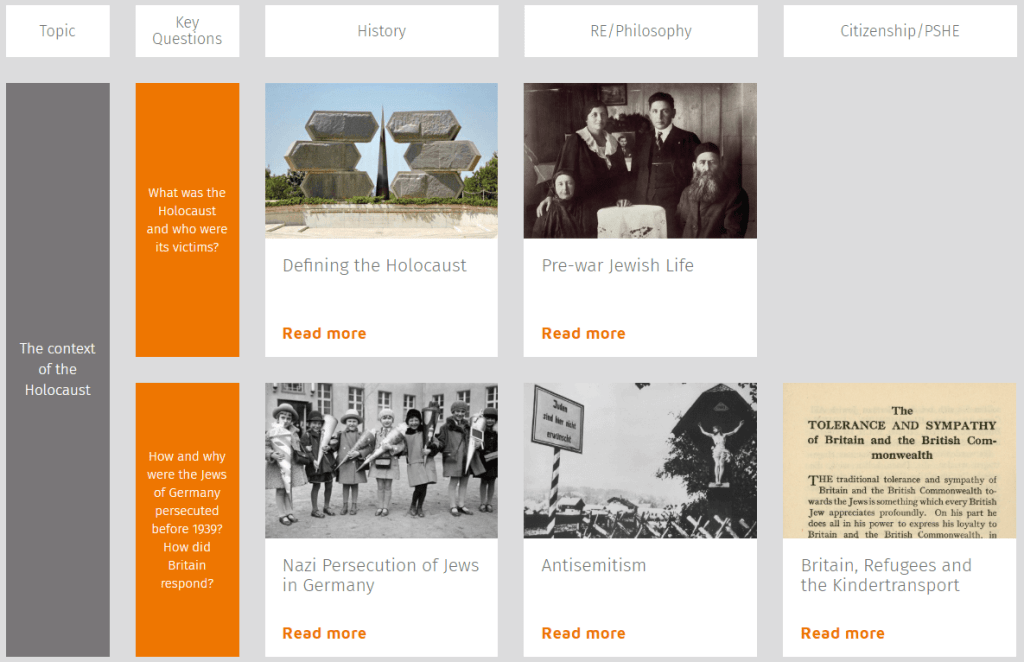
The Holocaust Education Trust produced ‘Exploring the Holocaust’, a free, comprehensive and flexible cross-curricular scheme of work.
The HET has built it around 15 core lessons in history, RE and citizenship or PSHE. You will also find additional resources which you can add to the scheme of work.
There’s also guidance on incorporating art into a programme of study on the Holocaust.
Fritz and Kurt
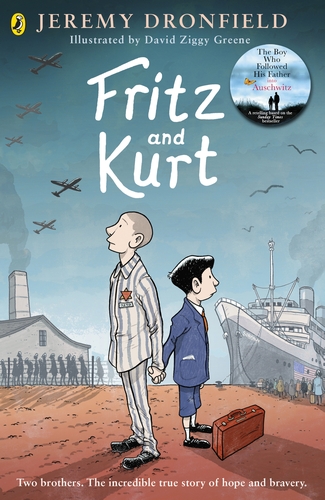
Fritz and Kurt is a book for children aged 9+, adapted from the bestseller The Boy Who Followed His Father into Auschwitz by Jeremy Dronfield.
It features the powerful real-life account of two brothers’ experience during the Holocaust. It’s an excellent way to introduce the topic in the classroom.
Download a free guide containing everything you need to help young readers get the most out of the book. It includes information and links to lesson plans and other teaching resources.
Holocaust timeline wall chart

Take a look at this UCU Holocaust Memorial Day wallchart, updated to include new sections about the fight against fascist organisations like the BNP and EDL.
Use it in your school to educate against the dangers of anti-Semitism, fascism and racial discrimination.
Belsen concentration camp
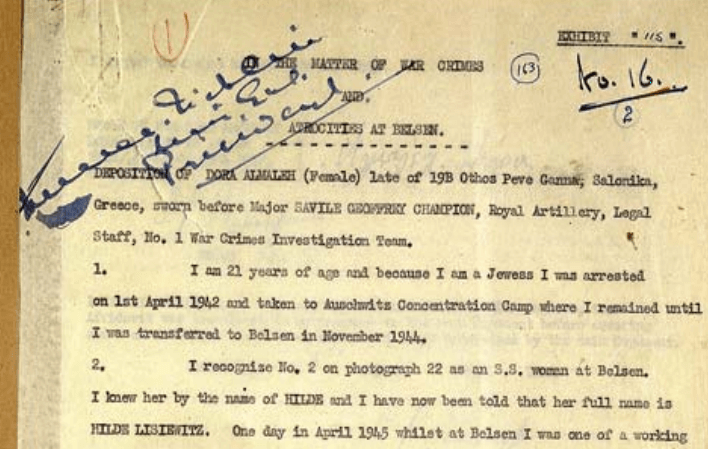
There were 40,000 prisoners at Belsen in April 1945, many dying each day. Thousands more had recently died and had not been buried.
Allied soldiers were deeply shocked by the conditions when they advanced into Germany at the end of the war. These documents from the National Archives record what the British soldiers found, and how they responded.
Anne Frank resources
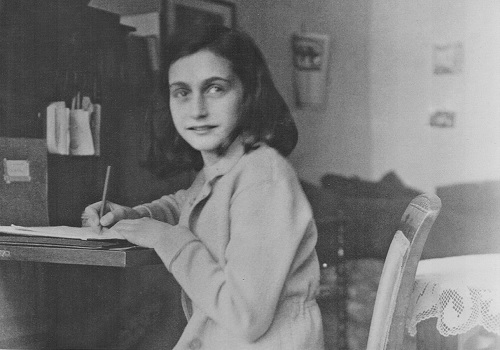
The Diary of a Young Girl by Anne Frank has long been the go-to text for educating young people about what life was like for those living in hiding from the Nazi regime.
Anne Frank Trust UK and Amnesty International produced a set of resources to go with this famous account, called Writing in Impossible Circumstances. It features teacher notes, lesson plans, a Powerpoint, resource sheets and curriculum links.
In the below video from Imperial War Museums, Jewish people recall how they were subjected to antisemitism as children before the Second World War.
Why primary children need to learn about the Holocaust

Bev Forrest explains how to give KS1 and 2 children a firm foundation of knowledge on this difficult subject, to set them up for a deeper understanding in secondary school
2016 was a special year for me. I achieved something I never thought I would be strong enough to do – I walked through the gates of Auschwitz-Birkenau.
As a guest of the Holocaust Educational Trust, I was privileged to join sixth formers and their teachers from my local area on a one-day visit to the site as part of the Lessons From Auschwitz Project.
The experience was profoundly moving. It culminated in an act of worship and remembrance led by a rabbi at the site of the gas chambers and laying lighted candles along the notorious railway tracks.
However, even more difficult for me to cope with emotionally was the opportunity I had just before our visit to meet Zigi Shipper. He is a Holocaust survivor who had entered those same gates aged only 14.
I listened to Zigi’s powerful testimony of surviving the camp and the extreme actions he had to undertake to do so. Then he told us how he had come to terms with those events; rather than thinking about blame, he was diverting his energy into looking for ways to challenge hatred and prejudice.
Contemporary relevance
Given the turbulent times we live in, Zigi’s story has great contemporary relevance with young people in school who have potentially fled persecution in their home country and possibly continue to face discrimination daily.
Based on these experiences, for me there is no argument as to whether we should educate young people about the Holocaust. Instead we should consider how we can do it in an age-appropriate way.
Some would argue that we are better leaving the study of the Holocaust to the secondary school curriculum, where it is a compulsory element within history.
“For me there is no argument as to whether we should educate young people about the Holocaust”
However, recent research indicates that even with this coverage, secondary pupils do not develop a secure sense of the geographical scale and chronology of the Holocaust.
If we can begin to study the topic at primary level, we provide a valuable foundation to build on at secondary level. This will therefore lead to better understanding.
British values
Many primary schools are struggling to find meaningful ways to meet the requirements of introducing British values. By studying elements of the Holocaust, can we provide a context and better understanding for areas such as respect and tolerance?
“Some would argue that we are better leaving the study of the Holocaust to the secondary school curriculum”
However, some say that given the horrors of the Holocaust it is not appropriate for study in primary school.
I agree there is the danger that by presenting a version appropriate for primary children, we may oversimplify and possibly trivialise the horror of those events.
Yet what I am advocating here is not teaching the Holocaust in its entirety to a primary audience. Instead, it’s about laying the foundation for a study of the Holocaust in secondary school.
Within the primary years, we should go no further than the start of the Second World War and focus on celebrating the richness of pre-war Jewish culture and stories of survival, mainly through the Kindertransport.
Inappropriate activities
I have seen many examples of primary teachers eager to make their contribution to challenging the evils of the Holocaust, yet floundering with poor knowledge and inappropriate activities.
Some teachers even ask pupils to write accounts as if they are in hiding or imprisoned in a camp, the aim being to instil empathy.
One example I saw was an activity where teachers divided pupils into Jews and members of the SS, then a game of hide and seek took place.
How can a child in the UK today possibly understand the emotions experienced by children in these circumstances? And even more importantly, should we even want them to be able to grasp them?
Trending
“Some teachers even ask pupils to write accounts as if they are in hiding or imprisoned in a camp”
In response to these dilemmas, the Holocaust Educational Trust launched a pack of free materials to support the teaching of Holocaust-related issues in primary schools.
Many teachers are worried about their lack of subject knowledge in this area. The trust has addressed that with an abundance of background material.
The resources focus on the normality of life for Jewish communities across Europe before the war. There are images of individuals enjoying family holidays, celebrating birthdays and engaging in everyday matters like going to school.
This is an area that secondary schools often lack sufficient curriculum time to explore. Such a focus enables pupils to not only explore the richness of Jewish culture, but also to highlight commonalities with their lives in modern-day Britain.
Individual stories
Through studying the culture, we can help children understand what was lost through the Holocaust. We can also help our pupils to avoid seeing Jews only as victims.
The scheme of work then goes on to look at life under the Nazis and the anti-Jewish laws. It concludes with a focus on the Kindertransport. Appreciating the value of individual stories, this lesson centres on one Jewish child, Vera.
By focusing on one Czech girl’s testimony, pupils can begin to understand the impact that the journey to our shores had on almost 10,000 young Jewish people. Pupils then go on to look at the actions and motives of those who helped children like Vera.
Through the use of materials produced by the Holocaust Educational Trust and other organisations, I hope you feel empowered to explore this controversial subject with your pupils.
Remember, before you embark on the journey think carefully about exactly what you want them to learn and gain from the experience.
While we do not want to expose primary pupils to the horrors of the Holocaust, you can give them the confidence to challenge the prejudice and discrimination which sadly continues in society today.
Further resources
The Holocaust Educational Trust’s website contains a complete scheme of work for primary schools. The accompanying guide includes a useful list of recommended Holocaust texts to use in literacy lessons. It also explains why The Boy in the Striped Pyjamas is an unsuitable source for study. HET can also support you in arranging for a Holocaust survivor to visit your school.
The Anne Frank Trust UK has been educating children about the life and diary of Holocaust victim Anne Frank for 25 years and has now extended its work with primary groups. Their workshops, aimed at Y6, aim to challenge prejudice and discrimination.
Tackling Controversial Issues in the Primary School by Richard Woolley (Routledge) has an excellent chapter on the subject. It is useful if you want to find out more about the theory behind the differing viewpoints related to the teaching of the Holocaust.
The Jewish Museum London welcomes primary groups and offers workshops focusing on Jewish culture and the Kindertransport. The website provides materials to support pre and post-visit work.
The National Holocaust Centre and Museum in Laxton, Nottinghamshire, uses a blend of artefacts and testimony to introduce KS2 pupils to the Kindertransport. It is also developing an outreach programme for schools unable to visit.
Bev Forrest taught in primary and secondary schools for many years. She is now a teacher trainer at Leeds Trinity University. She is also a member of the Historical Association Primary Committee and the editorial board of the HA journal Primary History. Browse more WW2 KS2 resources.
What one student learnt at Auschwitz
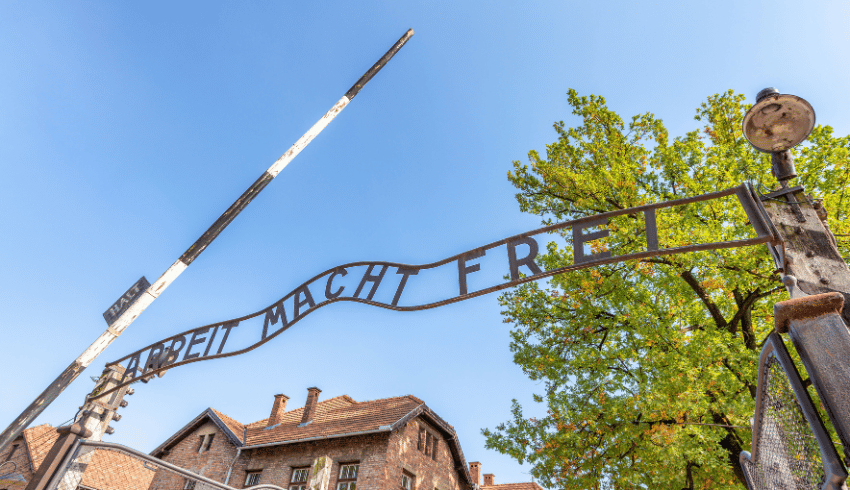
Y12 student Dominic Romano-Critchley talks about the impactful experience of visiting Auschwitz-Birkenau with the Holocaust Education Trust…

Visiting Auschwitz-Birkenau was a harrowing yet eye-opening experience. After having been myself, I believe it is a necessary experience for people to understand the scope and the humanity of the Holocaust.
The thing I was most shocked about was the scale. It is difficult to imagine seven million of anything, and even harder to imagine seven million people.
Seeing the vastness of the camps, the hair, the shoes, the crockery, even this didn’t seem to do justice to the sheer number of people sent here.
However, these personal items did serve to connect me more with the humanity and individuality of the Jewish people who lived and died at Auschwitz-Birkenau.
Heightened impact
Reading Primo Levi’s ‘If This is a Man/The Truce’ heightened my understanding of this sense of realising individuality. It documents one man’s experience at Auschwitz in excruciating detail, leaving nothing to the imagination.
Reading it in tandem with visiting the camp heightened the impact of the story. You have seen where he stood, where he lived, where he worked. The feeling of going there now is incomparable to that of almost a century ago. However, an atmosphere of despair still hangs over it.
The smell of death has since passed, but the feeling never will. Perhaps just as tragic as the tale of his time at Auschwitz is his account of attempting to reintegrate into society; how could someone live as they had before, live normally, after what he had seen?
Lessons from Auschwitz programme
When my school gave me the opportunity to apply for the Lessons From Auschwitz project, I was eager to sign up. Two sixth formers who had done it previously gave a presentation on it when I was in year 11. I was interested in doing it ever since.
However, when my application was initially denied, I felt almost relieved. It was as though some great weight had been lifted off my shoulders. However, just a few weeks before the project began, my school gave me a last-minute chance to join.
I was very hesitant, as I remembered how much of a pressure learning I would not be going alleviated. Despite this I reapplied. I am glad I did, because I gained an invaluable experience and a lifelong memory.
Different responses
Whilst it was powerful and horrifying, I felt frustrated. It seemed as though others around me were acting in a different way to me, which felt confusing. I seemed reserved and quiet, whilst others were animated and talkative.
Once I came to terms with the fact that they presumably were as affected by it as I was, I realised that people respond to these things in different ways.
It is impossible to judge how someone, or even yourself, will react when confronted with something so overwhelming. Something you can barely even come to comprehend before you go. Something it still feels difficult to grasp once you have seen it.
The project allowed me to attain a greater understanding of what happened, but also who it happened to. The humanity of the Holocaust is perhaps its greatest tragedy.
I urge anyone to apply for the project if the opportunity arises, or at least to go to Auschwitz-Birkenau at some point in your life.
Dominic Romano-Critchley is a Y12 student at Colchester Royal Grammar School. The Holocaust Education Trust organised the trip to Auschwitz.
The principles of appropriate Holocaust education
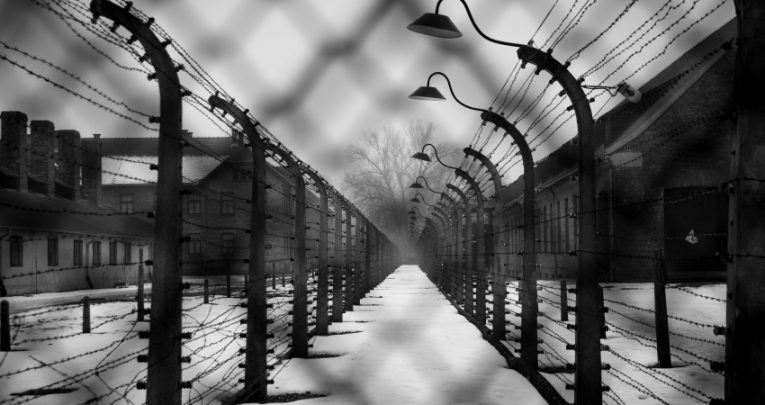
As a statutory history topic, teachers know that they need to teach the Holocaust to students, observes Mark Rusling from the National Holocaust Centre and Museum – but they don’t necessarily how…
Since 1991, the National Curriculum has required KS3 pupils to learn about the Holocaust in history.
As that subject’s only compulsory topic, we should expect pupils to have a strong grasp of the horrors emerging from a continent-spanning genocide that eradicated two thirds of European Jews.
The reality, however, is much more concerning. Research conducted among school pupils in England found that 15% couldn’t remember studying the Holocaust, and some worrying gaps in knowledge.
Over half believed that Hitler was solely responsible for the genocide of six million people, and that the killings took place in Germany alone. Worst of all, most were unable to explain why Jews were targeted.
Without this understanding, Holocaust education won’t prevent the kind of intolerance and persecution that might lead to the next genocide. So what would an appropriate Holocaust education look like in practice?
Three principles
At the National Holocaust Centre and Museum, we deliver Holocaust education to pupils from Y5 upwards, focusing on three principles, beginning with how and why the genocide developed.
We look at the ways in which key groups were responsible – the Nazi leadership; other countries’ leaderships; ordinary people who pulled triggers, guarded ghettos and manned death camps; and the bystanders in 22 countries who looked away. We prioritise the testimony of survivors whom students can meet and talk to, virtually or in person.
The second principle is that we should link Holocaust knowledge to modern-day challenges. This doesn’t mean searching for a ‘Holocaust angle’ across all examples of humankind’s inhumanity since 1945. But when we use secure knowledge to analyse the ‘othering’ of social, religious or ethnic groups by powerful actors, Holocaust education has the potential to prevent subsequent genocides.
Finally, we seek to develop critical thinking. Independent thought can prevent the mob mentality that fuels genocide. But this is only if this is based on secure, accurate and properly researched knowledge.
We can deliver programmes for Y5 to Y13 at our beautiful garden museum in Nottinghamshire, in schools or online. We provide a warm, friendly learning environment staffed by in-house educators who are all former school teachers. So use us!
Cross-curricular learning
You can embed the lessons of the Holocaust throughout the KS3/4 curriculum. In English, pupils could compare ghetto diaries with perpetrator narratives. Use RE lessons to discuss whether God can exist after the Holocaust.
In science, the anti-Jewish pseudo-science claiming evidence for ‘innate racial differences’ later adopted by Nazis can be the springboard for discussions of how scientific enquiry can be manipulated.
In PSHE, classes could explore how critical thinking can be used to debunk the antisemitic conspiracy theories that have gained considerable traction online in recent years.
A tough ask
Above all, however, prioritise Jewish voices and agency in the sources you choose for your teaching. If they tend to depict strong perpetrators and weak victims, that’s what the Nazis wanted you to think.
At the same time, ensure that pupils are sufficiently mature to engage with the subject matter – especially at Y8. This is increasingly the age at which students first encounter the Holocaust in history.
Teaching the Holocaust is a tough ask, but the rewards are enormous. Giving pupils secure Holocaust knowledge will enable them to better understand this uniquely destructive genocide. It will help them make sense of the difficult world in which they live, and in time, will run themselves.
It’s vital that we get this right.
Mark Rusling is the Director of Learning at the National Holocaust Centre and Museum. He can be contacted at education@holocaust.org.uk
Browse our pick of Remembrance Day activities.








